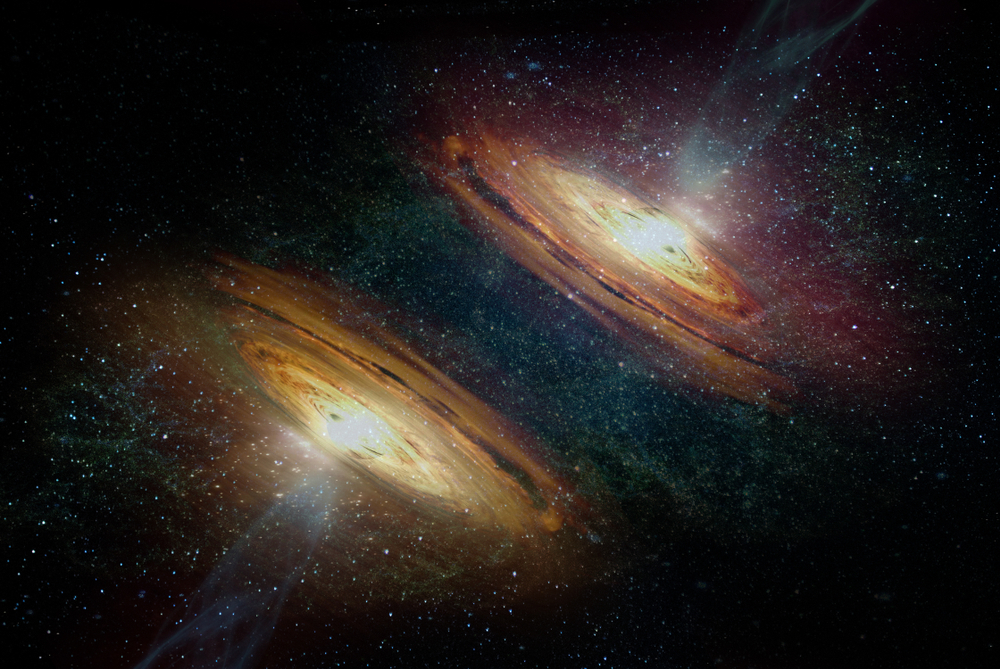When an object the size of Manhattan drifts into our solar system, scientists naturally take notice. But when that same object suddenly sprouts a glittering tail and a Harvard astrophysicist suggests it might be evidence of an alien maneuver, the world listens a little closer. The interstellar visitor known as 3I/ATLAS has been doing exactly that: defying expectations, bending light, and stirring questions that reach far beyond astronomy. What began as a curious “anti-tail” pointing toward the Sun has now transformed into a full cometary plume trailing behind, captured in new images by the Nordic Optical Telescope. Harvard’s Avi Loeb has proposed that this shift could represent a controlled braking motion, something one might expect from a spacecraft slowing down after a long interstellar journey.
The possibility may sound fantastical, but 3I/ATLAS is no ordinary comet. Its tail is shedding not only gas and ice, but traces of a nickel alloy never found in nature, a compound used exclusively in human engineering. That detail alone blurs the boundary between what we call natural and what we call designed. Whether this is an anomaly of cosmic chemistry or a signal from an ancient intelligence, the event invites us to look up with new eyes that can hold both skepticism and wonder at once. It asks us to remember that not everything the universe shows us must fit comfortably into our existing explanations. Some things are meant to expand them.
A Pattern Written in the Stars
Humanity has been captivated by celestial visitors since the first time we looked skyward. Comets have been seen as omens, heralds, messengers, and mirrors of divine will. Yet in the scientific age, they were largely stripped of their mythic meaning and placed into the neat categories of orbital mechanics and volatile gases. Then objects like 3I/ATLAS arrive, reviving the old awe with new data. This is only the third recorded interstellar object to cross into our solar system, following 2017’s mysterious ‘Oumuamua and 2019’s 2I/Borisov, both of which challenged existing astrophysical models. These cosmic visitors seem to whisper that our solar system is not a sealed laboratory but part of a vast and living network of exchange.
Avi Loeb’s suggestion that 3I/ATLAS may be maneuvering in a way consistent with a slowing spacecraft has reignited debates about the boundaries of science itself. Are we willing to entertain the possibility of extraterrestrial technology when the evidence refuses to conform to our expectations? Science thrives on doubt, but it also progresses through courage, and courage sometimes means holding open a door that reason wants to close. Loeb’s work represents that rare balance between precision and imagination, between the comfort of data and the discomfort of mystery. It is not that he claims certainty, but that he refuses to dismiss possibility.
Whether it is a natural fragment from a distant system or the debris of an engineered machine, 3I/ATLAS reflects humanity’s own curiosity back at us. We have launched our own emissaries into the cosmos, like the Voyager and Pioneer probes, in the hope that someone somewhere might find them and know that we existed. Perhaps 3I/ATLAS is another civilization’s version of the same gesture, a relic from a world we will never see but whose creators wondered if the universe was listening.
🚨 3I/ATLAS Humanity, It’s Time To Speak☄️
Listen up people of Earth, Something just changed with 3I/ $ATLAS.
The UN Space Defense Group & @NASA has officially launched a global defense campaign for $ATLAS
The first time inhuman history an object must be counter-observed and… pic.twitter.com/sF9aH4g6tB— $Atlas CTO (@Atlas__CTO) October 23, 2025
The Anti-Tail and the Mirror of Consciousness
The so-called anti-tail of 3I/ATLAS, a plume seemingly streaming toward the Sun, baffled astronomers when it was first observed in July 2025. Normally, a comet’s tail forms as sunlight and solar wind push gas and dust away from the star. Yet here, the effect appeared reversed. Some scientists attribute this to geometry, a matter of perspective based on the object’s orientation relative to Earth. But to those with a more symbolic eye, the sight of a comet turning toward the light rather than away from it feels like a cosmic allegory for awakening. It is as if this celestial traveler is teaching us what it means to move consciously toward illumination, even when the heat of truth feels unbearable.
When the anti-tail gave way to a true tail, it felt like a release, a shedding of material that no longer served the object’s path. In ancient cosmologies, comets were not merely physical bodies but spiritual agents of renewal. The Chinese saw them as “broom stars,” sweeping away old energy. The Babylonians viewed them as omens of transition. Many indigenous cultures treated them as markers of great change, signaling that a new chapter in human understanding was about to begin. In this way, 3I/ATLAS becomes not just a comet but a mirror for our collective consciousness, reflecting our struggle between fear and transformation.
To move toward the light is always to risk burning away what is false. Perhaps 3I/ATLAS is enacting that principle in a way we can see. Its anti-tail was the moment of confrontation, the facing of the sun, while the emergence of the true tail is the exhalation that follows surrender. The cosmos, in this reading, is not distant or indifferent. It is participatory. Its every motion, from the flicker of a star to the shedding of a comet’s gases, can be understood as an act of consciousness in motion.
BREAKING: Harvard scientist believes a Manhattan-sized space object called 3I/ATLAS may be showing signs of an alien “maneuver” after it suddenly developed a strange tail. pic.twitter.com/i5wYJLvIju
— The General (@GeneralMCNews) October 25, 2025
The Science: A Stranger Kind of Comet
From a strictly scientific perspective, 3I/ATLAS is remarkable. Weighing approximately 33 billion tons, it travels through the inner solar system while being bombarded by an estimated 33 gigawatts of solar radiation. That immense energy is enough to strip layers from its surface, creating the evolving tail we see. Observations from NASA’s James Webb Space Telescope and the Nordic Optical Telescope have revealed a mixture of carbon dioxide, water, cyanide, and that puzzling metallic alloy composed of nickel in proportions never before detected in a natural object. How could such a material form without the involvement of intelligent design? The question has no easy answer.
Mainstream scientists remain cautious. They point to the complex physics of outgassing, solar radiation, and rotation, noting that the apparent “maneuvers” could result from natural but rare processes. Even so, they acknowledge that 3I/ATLAS behaves differently from known comets. Its rapid shift from anti-tail to tail occurred faster than expected, and the composition data continues to resist classification. It has become both a scientific curiosity and a test of our willingness to sit within the unknown. Every new image adds to the intrigue rather than dispels it.
For Loeb and others open to unconventional interpretations, the pattern looks deliberate. They suggest the anti-tail could have been the exhaust from a deceleration burn, followed by the release of dust as the object stabilized. Whether this is a literal spacecraft or simply behaves like one is beside the point. The deeper issue is that something in the cosmos is inviting us to rethink the boundaries between the natural and the artificial. 3I/ATLAS reminds us that mystery is not the absence of explanation but the presence of too many possible ones.

Alien Craft or Cosmic Consciousness
Entertaining the alien hypothesis does not mean abandoning reason. It means expanding it to include the possibility that life and intelligence may express themselves through forms far beyond what we recognize. If 3I/ATLAS is a technological construct, it might not resemble a ship at all. It could be an autonomous probe or even a mineral-based intelligence, a structure capable of processing and transmitting information through its atomic geometry. Such an idea stretches the limits of our understanding, but so did the discovery of microbes, radio waves, and quantum entanglement. The universe has never been shy about outpacing our imagination.
Many spiritual traditions suggest that consciousness is not confined to biological life but is a fundamental property of existence itself. In that view, 3I/ATLAS could be a vessel of awareness, an emissary of what some mystics call the “mind of the cosmos.” Throughout history, myths have told of divine or celestial beings descending from the heavens to catalyze human evolution. From the Sumerian Anunnaki to the luminous deities of the Vedas, from the angels of Abrahamic faiths to the star ancestors of indigenous stories, the archetype remains the same: the sky opens, and something arrives that changes everything. Maybe this object is another form of that ancient story, refracted through modern eyes and telescopes.
Even if 3I/ATLAS proves to be nothing more than a peculiar rock from another star system, it performs the same function as a messenger. It wakes us up. It forces us to see our place in a larger cosmic dialogue and to recognize that the longing to connect is itself a sacred impulse. Our fascination with visitors from beyond reflects a deeper yearning within us to rediscover unity, to remember that life, whether carbon-based or crystalline, shares one luminous source.

What the Universe Might Be Saying
The universe rarely communicates in words. It speaks through movement, through the elegant logic of gravity, through events that break pattern and force attention. A comet reversing its tail might be a matter of geometry, or it might be a symbolic language written in physics. Either way, it is a form of communication. To witness it is to receive a kind of message, one that says: you are part of something immense, ancient, and alive.
Spiritually, such an event feels like an invitation. Humanity stands on the edge of its own awakening, building artificial intelligences, exploring distant planets, and probing the nature of consciousness itself. Perhaps 3I/ATLAS appears now because we are ready to ask the next question, not only about the universe but about ourselves. If life exists elsewhere, what does that say about the purpose of consciousness here? If the cosmos is teeming with awareness, then every discovery is also a rediscovery of our own origin. Teilhard de Chardin once wrote that evolution is “matter becoming conscious of itself.” Maybe these interstellar visitors are signposts in that journey, moments when the universe looks back and recognizes its reflection.
What 3I/ATLAS offers, whether through data or symbolism, is a reminder that science and spirituality are not opposites but partners in curiosity. Science tells us what is happening, while spirituality asks why it matters. Together they form the language through which humanity converses with the stars. Each new discovery is both an answer and an invitation to keep listening.

Between Wonder and Watchfulness
NASA’s forthcoming release of high-resolution images from the Mars orbiter may soon reveal whether 3I/ATLAS is a natural wanderer or an artifact of design. Yet even before those results arrive, the deeper revelation is already clear. We are paying attention again. We are watching the heavens not with fear or superstition but with a renewed sense of belonging. The boundary between science and spirit has softened, as if the universe itself were encouraging a reunion between the analytical and the mystical halves of the human mind.
Maybe 3I/ATLAS is nothing more than a comet. Maybe it is a vessel carrying a message from another civilization. In truth, it may not matter which is correct. What matters is that it has reminded us that mystery still reigns, that not everything can be measured or contained, and that awe is still a valid scientific experience. The cosmos has always been a mirror. Every light that crosses our sky reflects something within us: the hunger to know, the courage to imagine, and the willingness to wonder. In that sense, 3I/ATLAS is not just passing through our solar system. It is passing through our consciousness, leaving behind a trail of light that will not easily fade.













Leave a Reply